
How To Teach Śaivism to Children (Age 8)
Co-authored with Dhara.
We decided to introduce religion to Sabi at the age of six. Instead of teaching her from a book, we took her on a 21-day road trip and let her experience various sects of Hinduism—learning not through sermons, but through movement, landscapes, rituals, and people. We also trained her in gada yuddha—mace martial arts—not for self-defense, but as a form of prayer to Hanuman. We showed her that prayer doesn’t mean submission; it means living what the deity stands for. It means transformation.
By age eight, her awareness had grown. So had her reading stamina. In the last year, she completed four serious books on Maratha history: James Wales (209 pages), The Maratha Century (291 pages), The Era of Bajirao (340 pages), and The Epoch of Nanasaheb Peshwa (452 pages).
To celebrate this, and to deepen her understanding of the Indic way of life, we did two things in 2025.
- First, our family friend, Srinivas Iyer, took her on a pilgrimage to Sabarimala.
- Second, we took her to Trimbakeshwar — a jyotirliṅga temple near Nashik.
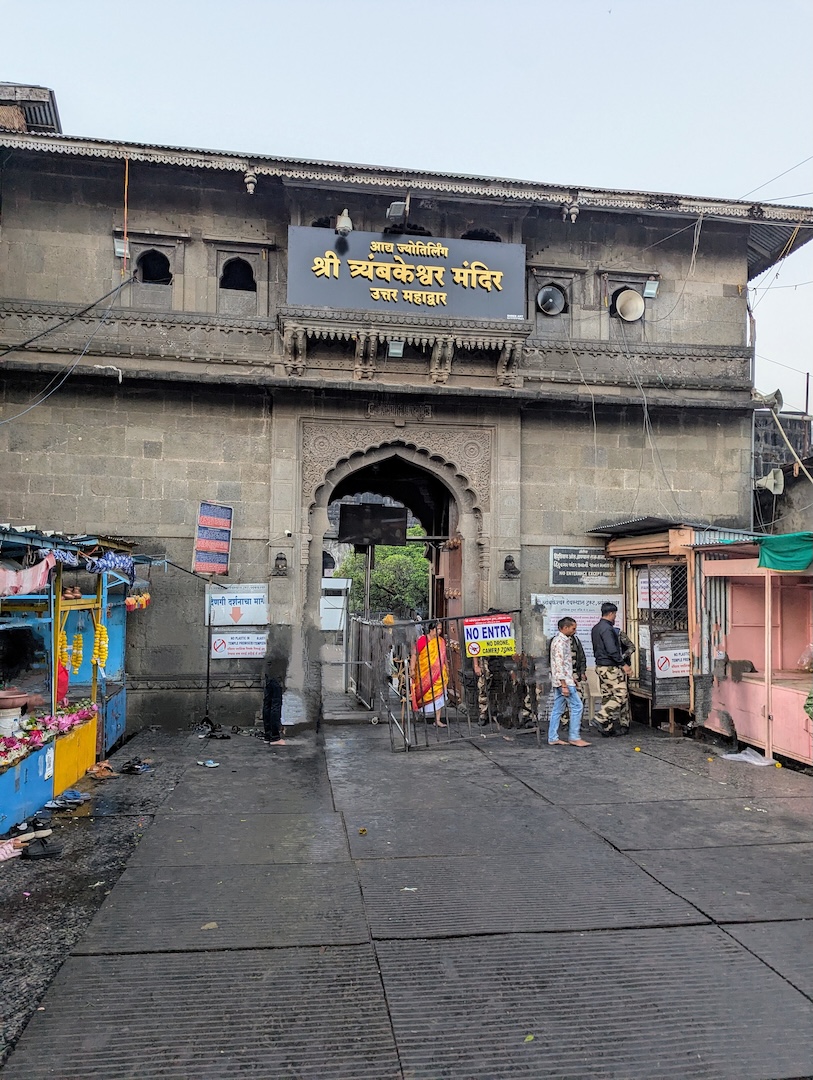
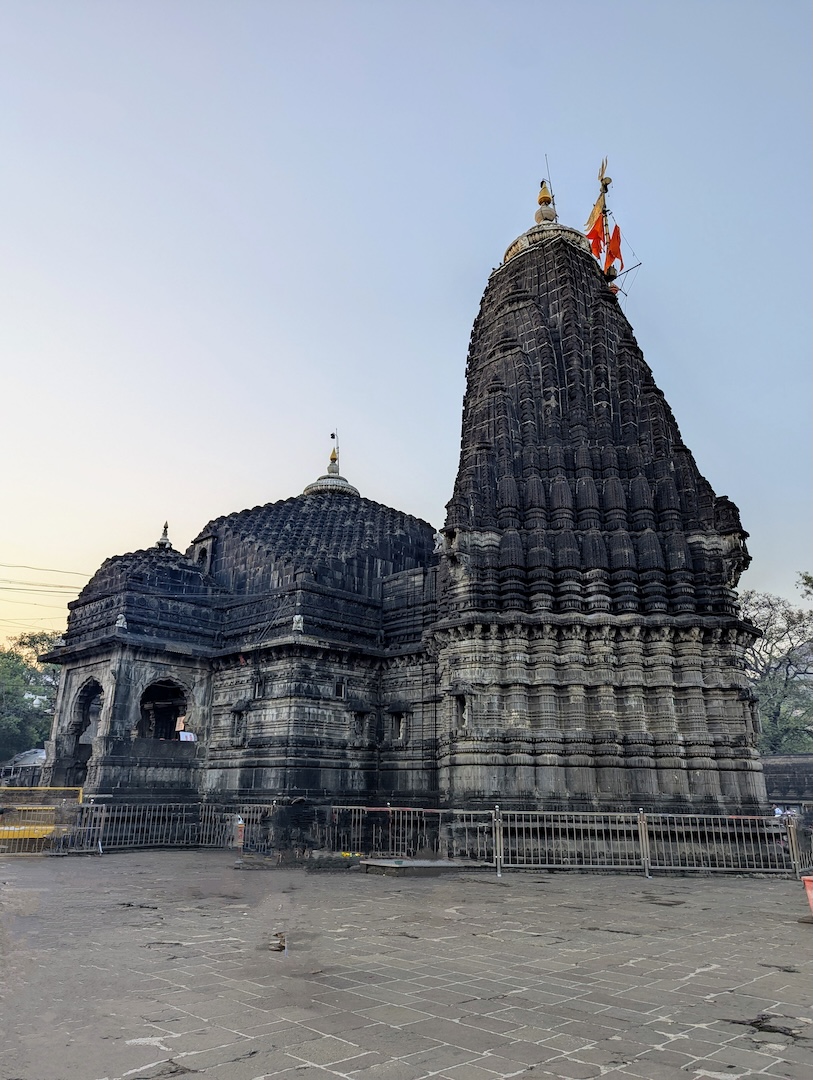

Why Trimbakeshwar?
The choice was deliberate. It worked on many layers.
- Personal: The temple was built by Nanasaheb Peshwa, whom she had just read about.
- Father’s connection: In 1995, I lived there for 13 days with Pandit Suresh Dixit — a Tamrapatradhari Purohit. Tamrapatradhari means “holder of the copper plate.” They’re priests whose lineage and authority were formally recognized by Nanasaheb himself. His teachings deeply shaped how I see reality. That’s part of what I passed to Sabi.
- Family lineage: My father’s śrāddha — his ancestral rites — were performed at Trimbakeshwar.
- Knowledge lineage: Non-dual Śaivism began in Kashmir, flowed south through Nath yogis and Agamic traditions, and was preserved here by the Tamrapatradharis.
- Spiritual uniqueness: Among the 12 jyotirliṅgas, Trimbakeshwar is rare. Its tri-faced linga invites seekers to realize, not just to worship.
During the visit, we met Pandit Rajesh Dixit — son of Pandit Suresh Dixit. We spoke at length about Non-dual Śaivism.
🚨 Please do reach out if there are inaccuracies that arise out of lack of understanding. 🙏🚨
Nature of Reality
"I was there before there was nothing. Who am I?"That question is the heart of non-dual Śaivism. You don’t start with dogma. You start with direct inquiry.
No-Thing with ♾️ Potential
God (Śiva) is not a thing. God is the potential for everything. Śiva is the unmanifest, the formless Absolute. He is also called Brahman.
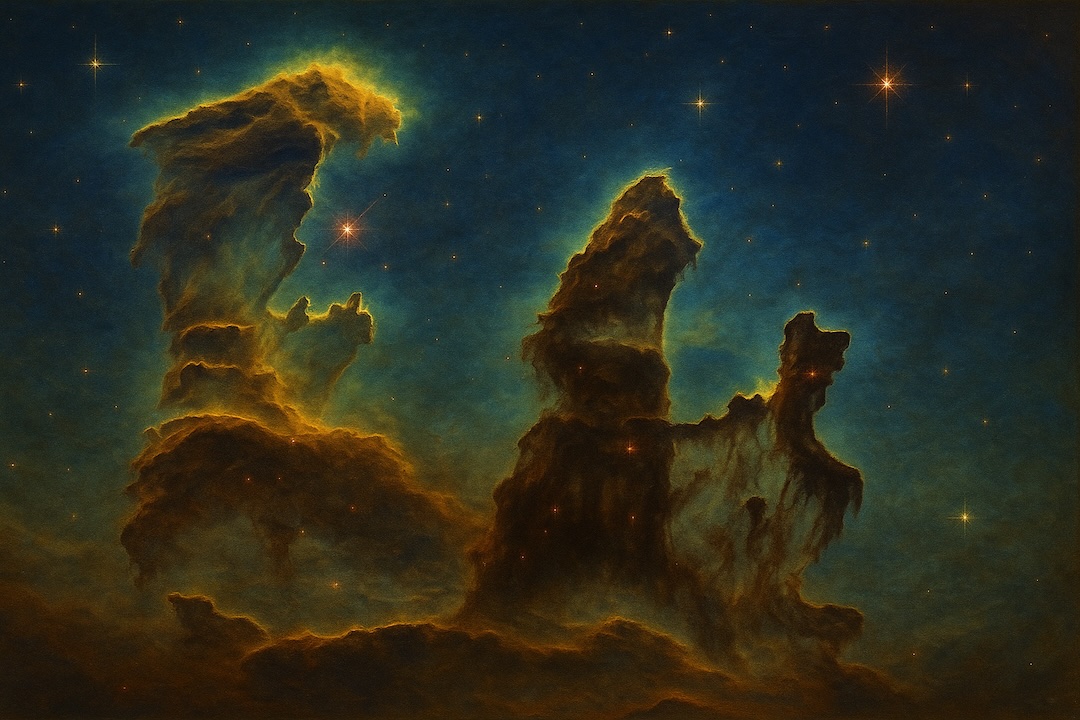
Scriptures describe him like this:
śivam śāntam advitīyam nirākāram nirañjanam
> Śiva is peace, non-dual, formless, and untainted.Śiva isn’t empty. He’s infinite potential. Within Śiva are three components:
- Śakti (Potential Energy): The power to inspire, create, express, and, act.
- Maya-tattva (Potential Matter): Temporary particles flickering in and out of existence.
- Cit (Universal Consciousness): Universal consciousness.
You = ātmā = Śiva – Cit
śivoham
> I am Śiva.Your true Self — ātmā — is not separate from Śiva. However, you are unaware (without Cit) of it.
Śiva 🕉️ and Śakti 🔥
Both need each other. They are not optional halves. They are complementary forces.
Śiva without Śakti is like a lamp with oil and wick — but no flame. All the capacity, but no activation.

Śakti without Śiva is a wildfire. 💥 Powerful, but uncontained without a lamp to guide it. Śakti without Śiva will either be chaotic or burn out quickly.
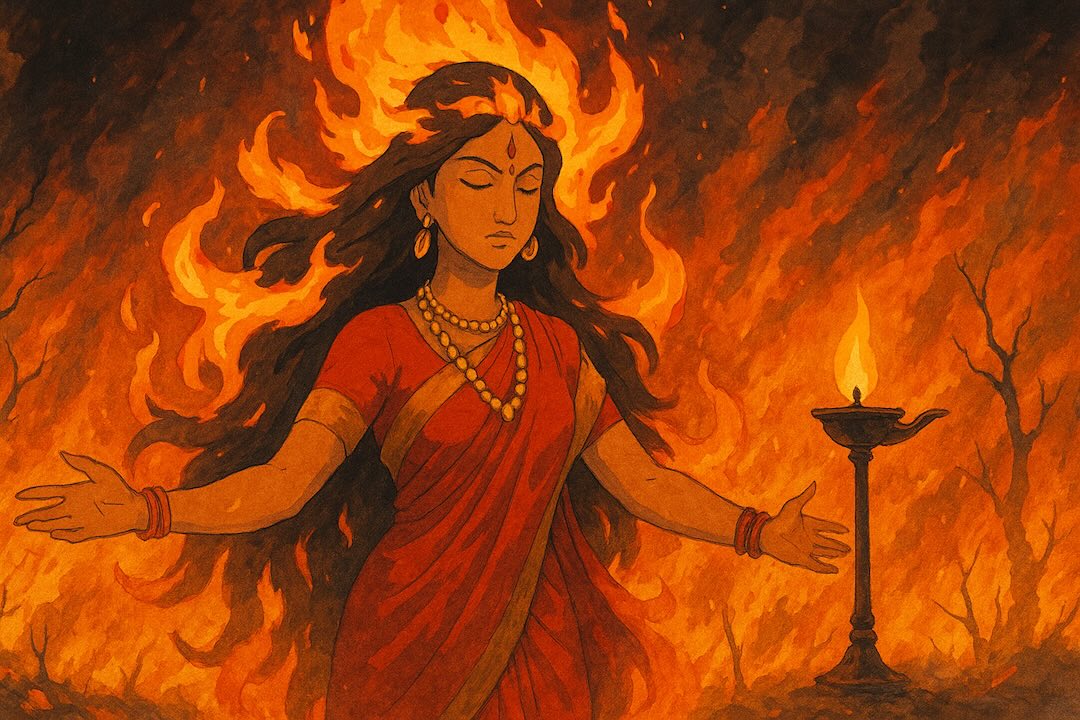
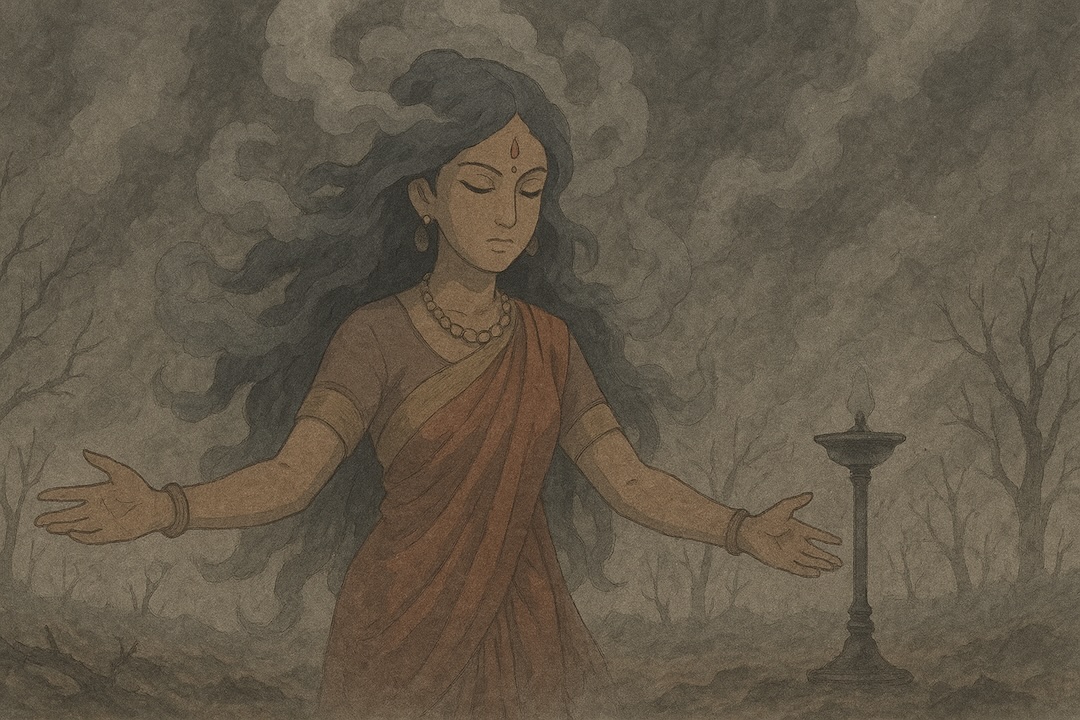
Don’t confuse Śiva and Śakti with man and woman.
- They are principles: Śiva is stillness, awareness, silence. Śakti is motion, energy, creation.
- A woman meditating is channeling Śiva. A man dancing is channeling Śakti. Each person expresses both, regardless of gender.
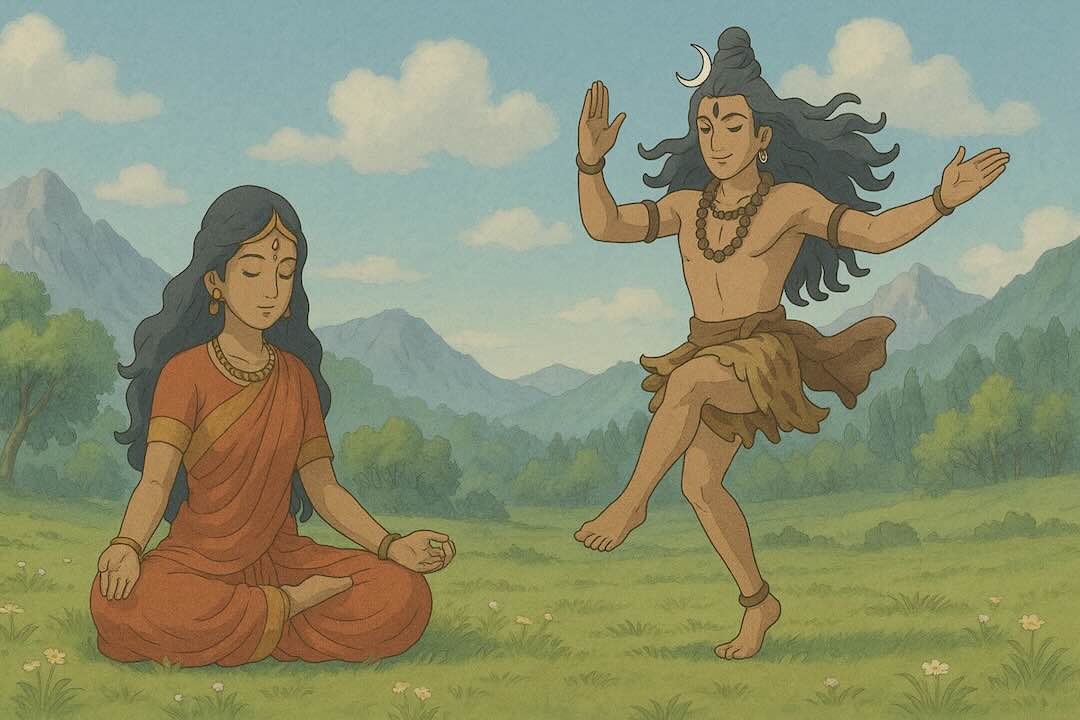
Outcome-Oriented Path
Advaita Vedānta says the world is an māyā (illusion). Jainism says icchā (desire) is a flaw. In comparison, Śaivism says: icchā (desire) is divine. Life is sacred. You are here to experience it fully — with awareness. Every action, thought, and breath is līlā — Śiva’s play. Live it skillfully to progress Dharma.
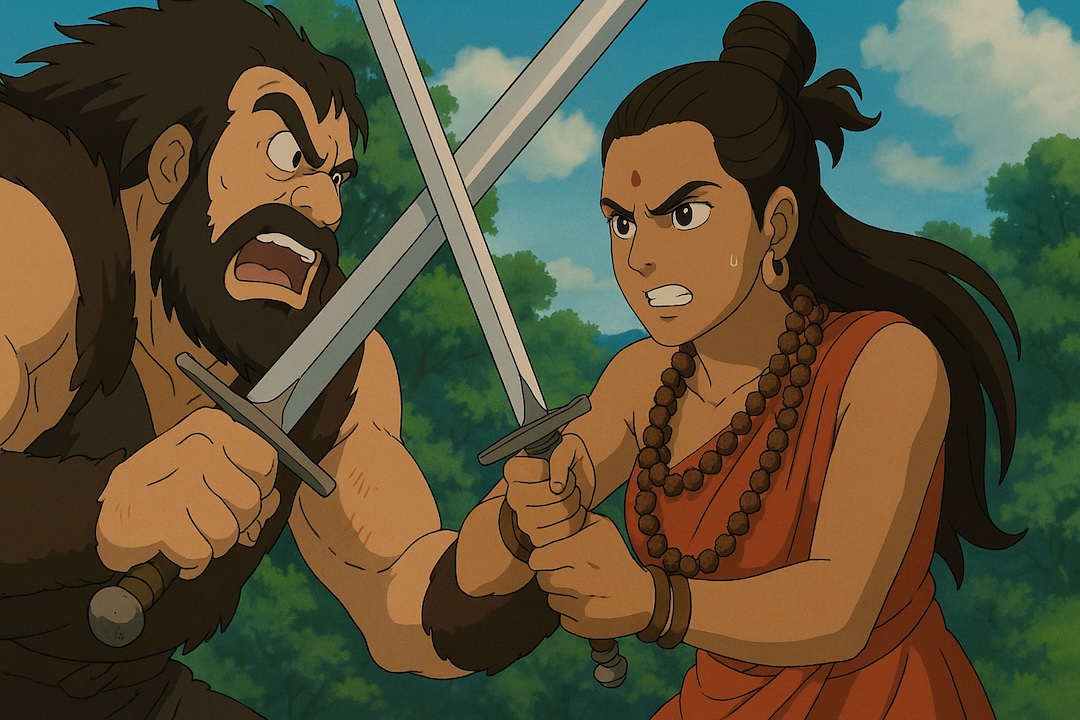

One who believes the world is an illusion… doesn’t.
Śakti – Śiva = Chaos
In myth, when Kali emerged from Durga’s wrath, she destroyed everything in sight. She was power, unbound. Even after the battle ended, Kali kept raging. Śiva stepped into her path. He didn’t fight. He lay still. The moment she stepped on him, all the excess energy got flushed out. Her fury stopped. She remembered herself. That’s what Śiva does — he grounds Śakti.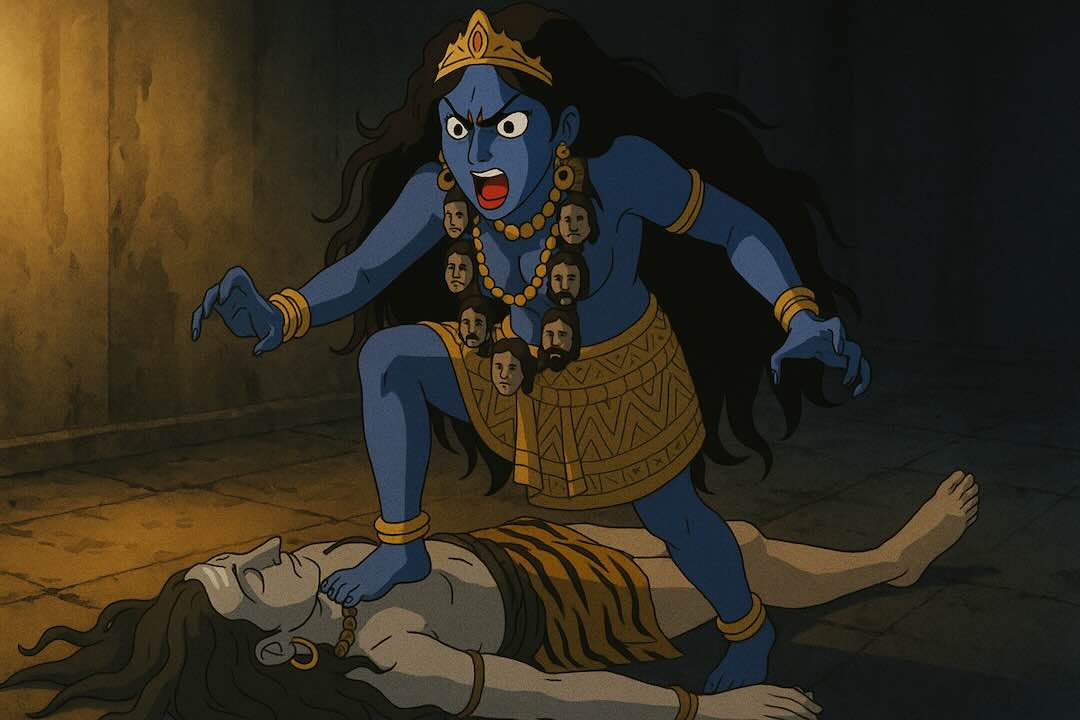
Signs You’re Missing Śiva:
- You’re acting constantly, but without direction.
- You’re full of energy, but scattered.
- You never pause. Stillness makes you uncomfortable.
- You’re emotionally volatile.
- You crave validation.
- You’re reactive.
- Life is full of the right things, but you feel hollow.
Recognize Cit
caitanyam ātmā
> Consciousness is the Self.Cit is universal consciousness that connects everything, no matter how different, absurb, or evil it may seem. When meditating, learn to recognize and remember Cit.
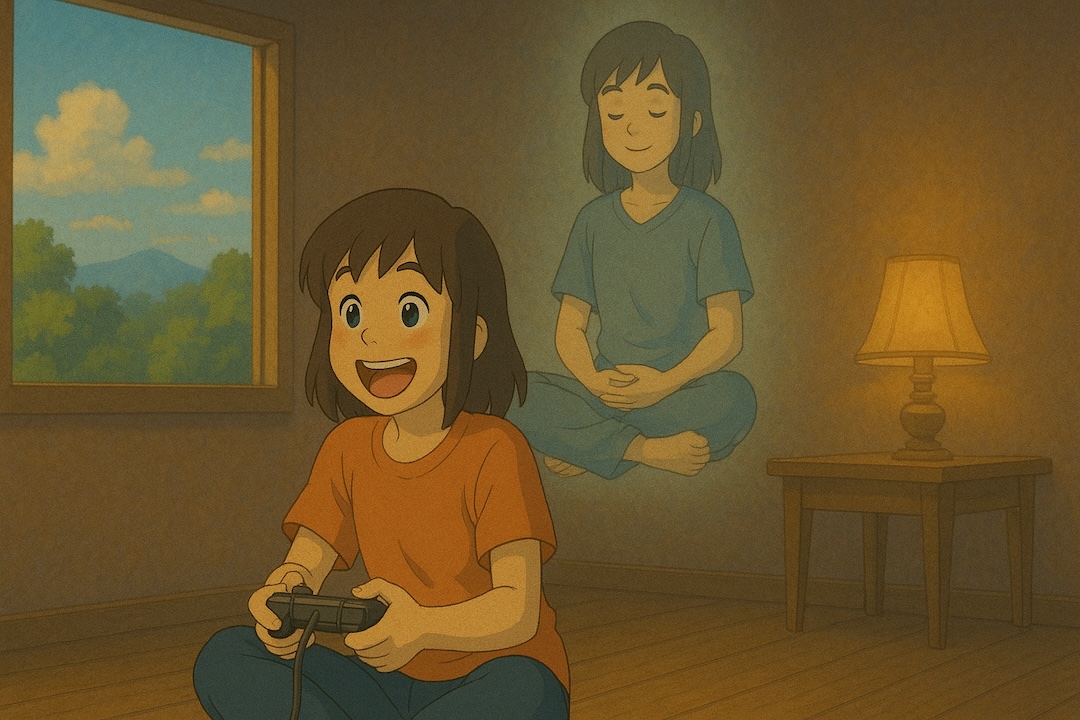
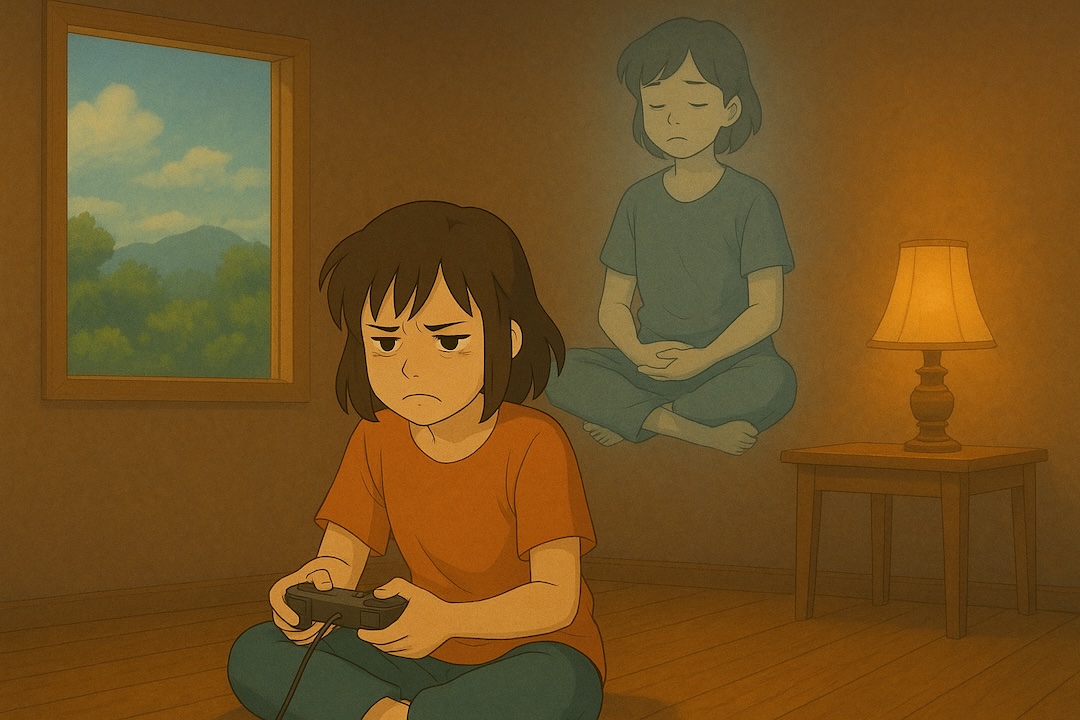
Here’s how you can understand it:
- Life is a video game.
- Your ātmā is the player — silent, aware, unchanging.
- Your prārabdha karma 🧬 defines your avatar, level, and in-game physics.
- Your antaḥkaraṇa is your game controller (🎮, 🕹️, 🥽):
- Manas – processes sensory input and uncertainty
- Buddhi – makes decisions
- Ahaṅkāra – says “I am this”
- Citta – stores memory
- Body
- Māyā makes you forget (āvaraṇa) Cit by showing you a fake world (vikṣepa) through graphics and storytelling.
māyā māyākāryaṃ sarvaṃ mahadādidehaparyantam | asadidam anātmatattvaṃ viddhi tvaṃ marumarīcikākalpam
> Māyā is that which makes the real appear unreal, and the unreal appear real. It veils the truth of the Self and projects the illusion of separateness.- Your choices and actions in the game are karma.
- Your ethics are dharma.
Your duty? Play skillfully to promote dharma, while remembering Cit.
Why it matters: Adharma
When Cit contracts due to Māyā, distortion happens.
- Icchā becomes compulsion
- Jñāna becomes ignorance or delusion
- Kriyā becomes harm or exploitation.
This is how Adharma—disorder—begins. But Śakti doesn’t disappear. When distorted, Śakti becomes Adharma and spreads like wildfire.


Solving Adharma
Do you feel the impulse to oppose Adharma? That’s Śiva acting through you.
If that Adharma is within you, then offer it to Śiva and trust. Just as he drank poison during the Samudra Manthan, he can absorb your pain without being harmed.
If that Adharma is external, then Śiva doesn’t want you to oppose from outside or suppress it. He wants you to transform Adharma by awakening awareness within them.
When fighting against the Adilshahi and Mughal empires, Shivaji did not aim to expand the Bhonsale dynasty’s power. Instead, he exposed how both empires were extractive and oppressive (Adharmic), and went on to establish Swarajya — a sovereign kingdom built on justice and self-rule for the people.
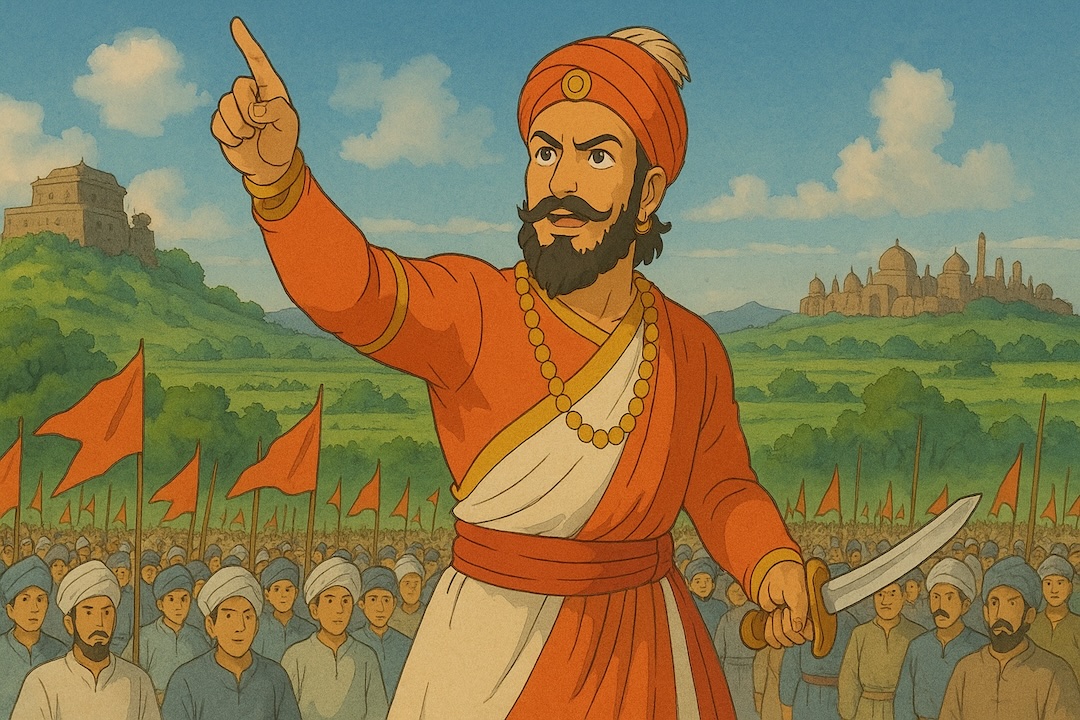
Śiva – Śakti = Corpse
Śiva without Śakti is inert. That’s why he’s shown in cremation grounds and covered in ashes. He sits among death — not morbid, but unmoved. Still. Watching. Waiting. But creation and life slows down when this happens.
In myth, Parvati (Śakti) does tapas. She prays, dances, offers love to stir Śiva out of stillness. Eventually, he opens his eyes and recognizes her as his equal. This union kickstarts and endures creation.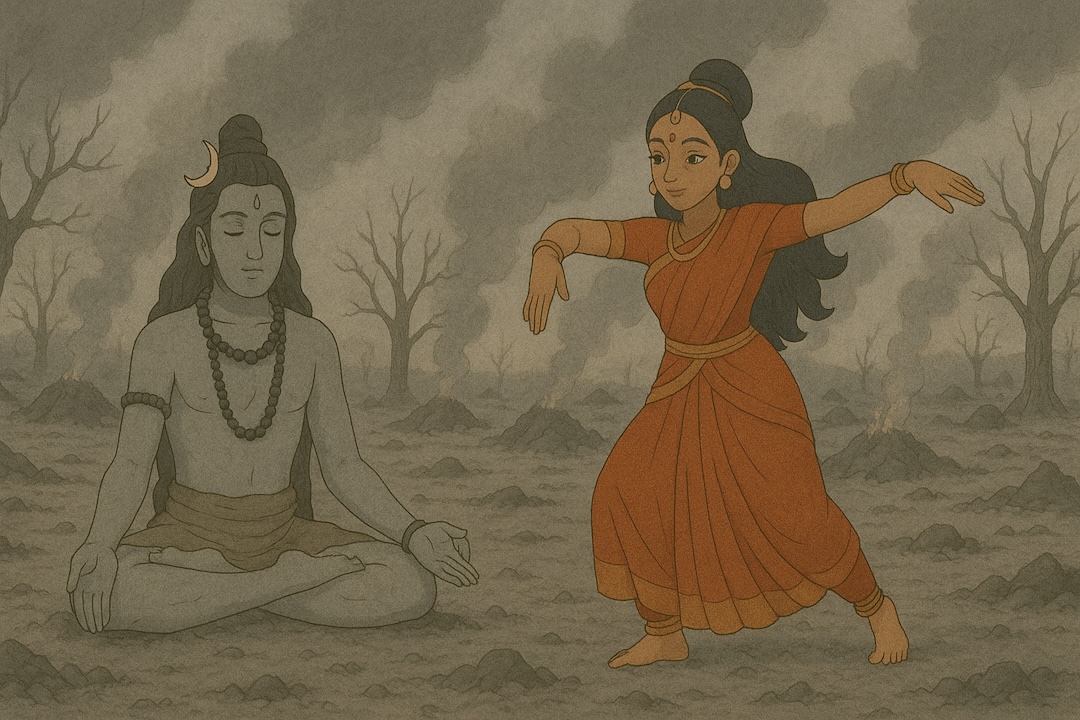
Signs You’re Missing Śakti:
- You have vision but no drive.
- You’re at peace but uninspired and bored.
- You observe Adharma, but don’t act.
- You’re spiritual, but don’t feel joy.
- You avoid life’s mess.
- You get insights, but do nothing with them.
- You feel stagnated.
Dṛṣṭi: Perception
Dṛṣṭi is observing reality for what it is. This is the first step to creation because vision shapes reality.
yathā dṛṣṭā tathā sṛṣṭi
> As your vision, so your creation. In quantum physics, some interpretations suggest that a particle’s state isn’t determined until it’s observed.While Cit connects you to the larger reality, you still need to engage with everyday life. That’s where vimarśa comes in. You use your mental faculties (ahaṅkāra) to build a conceptual model of the world (vikalpa)—your personal perspective of reality. How you perceive the world determines how you act.

After decades of Islamic invasions, large parts of South India were left politically fragmented and culturally shaken.
Many viewed the collapse as permanent — the end of dharma — and accepted subjugation or conversion.
Vidyāraṇya saw something different. He saw the possibility of revival. He studied and brought Sarasvatī’s jñāna śakti into real-world statecraft. He mentored the brothers Harihara and Bukka — not only in strategy, but in vision. Under his guidance, they founded the Vijayanagara Empire: a political and spiritual renaissance.Icchā Śakti: Divine will
Many traditions see icchā (desire) as a flaw or something to overcome. In Śaivism, icchā is considered divine. It’s the primal pulse of the Śakti inside you.
The best desires come from ānanda — uncontainable aliveness that results in the urge to create, play, love, express.

You must nurture it and grow it. People with strong icchā tend to be obsessively passionate, highly energetic, and their passion is contagious.
How to cultivate Icchā
- Have śraddhā — trust your longing
- Practice saṅkalpa-śuddhi — remove tamasic, egoic desires that come from indulgent pleasure, emptiness, or escape.
- Awaken kuṇḍalinī (energy pathway) — through mantra (AIṂ, HRĪM, KLIṂ), breathwork, and kriyā
- Feel the Spanda — the pre-thought pulse of inspiration. Every time you touch the Spanda, it sends a throb, pulse, vibration, or energy through you. Breathe in “SO,” exhale “HAM.” Feel: “I am Cit.”
- Surrender: Let Śakti flow through you.
| Beej Mantra | Purpose | Aspect | Devi |
|---|---|---|---|
| AIṂ | Awareness | Intuition | Sarasvatī |
| HRĪM | Self-awareness | Self-aware being | Bhuvaneśvarī |
| KLIṂ | Expression | Will to act | Kāmeśvarī |
Jñāna Śakti: Knowledge
From icchā arises the need to know. Jñāna is not just information—data and words. It’s the ability to see patterns, think beyond concepts and opinions, and recognize truth. Jñāna Śakti demands that you spend as much time reflecting, realizing and imbibing as you do reading.
Kriyā Śakti: The will to act
Icchā and jñāna enable you to act consciously and effortlessly. In Śaivism, all work is sacred. Parenting, building, even speaking — all become yoga.
Sṛṣṭi (Manifestation)
Sṛṣṭi means creation — the act of manifesting reality from subtle to visible. For example:
- To fullfil Vishnu’s need to create the material world, Brahma manifests
- To fulfill Brahma’s need for knowledge, Sarasvatī manifests
Each step is a divine unfolding of consciousness into form.
How to live
Mental Process 🧬
What differentiates you from an animal? Animals live by instinct. Humans live by awareness. You are Cit manifesting reality through body and mind. So control over thoughts, feelings, and memories isn’t optional. It’s how you evolve.
- Meditate on Cit — your oneness with all.
- Recognize all your actions (karma) is remembered.
- See Māyā not as evil, but as distortion that keeps you from remembering Cit.
- Don’t treat Adharma as evil. Treat it as misdirected Śakti.
- Take effort to keep improving your cognition system (antaḥkaraṇa) — how you perceive the world.
- Manas – Learn to doubt what your senses tell you.
- Buddhi – Choose thoughtfully; don’t just judge.
- Ahaṅkāra – Notice if your self-image is holding you back.
- Citta – Notice if your past is shaping your present too strongly.
- Don’t only read. Reflect, realize and imbibe to build Jñāna Śakti.
Experiential Learning
Jñānaṁ bandhah
> Limited knowledge is bondagejñānam vina anubhavaṁ na siddhiḥ
> Without direct experience, knowledge cannot bring liberation. - AbhinavaguptaAnubhava: You can describe a lemon all day. But until you taste it, you don’t know sour. Same with Śiva, Śakti, Cit, Māyā, etc. Concepts aren’t enough. You must live it. This is Anubhava — direct realization. It takes time, effort, and the right guide.
Guru-Śiṣya Paramparā: Learning happens through trial and correction. The guru doesn’t give answers. They let you try, fail, and then reveal. Doing → Feedback → Reflection → Transformation. That’s the cycle.
You don’t imitate Śiva. You become him through experience.
Dialogue (Samvāda)
In Tantric texts, Śakti is always asking questions. Not because she’s ignorant — because she seeks revelation. A question is the spanda (pulse) of icchā (desire to know) flowing into knowing (jñāna), then doing (kriyā).
- That’s how Arjuna seeks from Krishna.
- That’s how Parvati questions Śiva.
Ask. Converse. Reflect. Truth reveals itself in dialogue.
Astrology (Grahāḥ)
Most people use astrology for prediction. Śaivism uses it for awareness.
Grahāḥ — the planetary forces — are not fate. They’re used as tools during reflection to identify how you are experiencing a certain time and situation. Not what’s going to happen. They’re mirrors, not crystal ball.
Śaivism and Hinduism
From outside, Hinduism looks like a mess of millions of gods:
- Anything can represent the divine. Man. Woman. Animal. Ancestor. River. Stone.
- Each god has infinite forms. Śakti alone becomes Lakṣmī, Sarasvatī, Kali, Durga, Annapurna, Sati, Parvati, Chandi…

Outcome-Oriented Path
But that’s only the surface. The point isn’t the name. It’s the transformation it unlocks in you.
Śaivism is not just about mokṣa — liberation. Śaivism is about living effectively, now. It sees religion not as a judge or punisher, but as a technique to live better.
To get icchā, jñāna, and kriyā in a specific context and domain, you can create or pick a deity that is best equipped to help you. Pray to that deity. Debate with it. Problem solve. Wrestle. Ask questions. This back-and-forth will result in a transformation (and growth) in you.
Specific Instances:
Shivaji channeled Tulja Bhavānī to achieve strength and divine sanction to create Swarajya—a just and dharmic Hindu kingdom. She gave him courage and his sword — the Bhavānī Talvār.
Srinivasa Ramanujan dreamt of math formulas given by Namagiri (Laxmi Devi). The deity gave him dreams of mathematical formulas, which he recorded and later used to produce pioneering work in number theory, infinite series, and modular functions—despite no formal training.
Rana Pratap worshipped Eklingji as his sovereign-lord to achieve moral strength in resisting Akbar’s adharmic rule.
Vidyāraṇya tapped into Saraswati to revive Hindu rule in South India after years of Islamic invasions. He mentored Harihara and Bukka unify fragmented regions and lay the philosophical and administrative foundations of the Vijayanagara Empire.
Chandragupta Maurya ruled an empire. Then renounced it at 42. Became a Jain monk.In general:
- Business people pray to Lakṣmī (wealth).
- Students pray to Sarasvatī or Gayatri (learning).
- Farmers pray to Bhūdevī and Annapurna (earth and nourishment).
- Warriors pray to Durgā (power). Maharaja Ranjit Singh’s flag had the image of Duraga.
- Fitness lovers pray to Hanuman — a form of Śiva.
- Weapon bearers in the South pray to Murugan (Kārtikeya).
Religion isn’t about fitting in. It’s about tapping into power to create positive change.
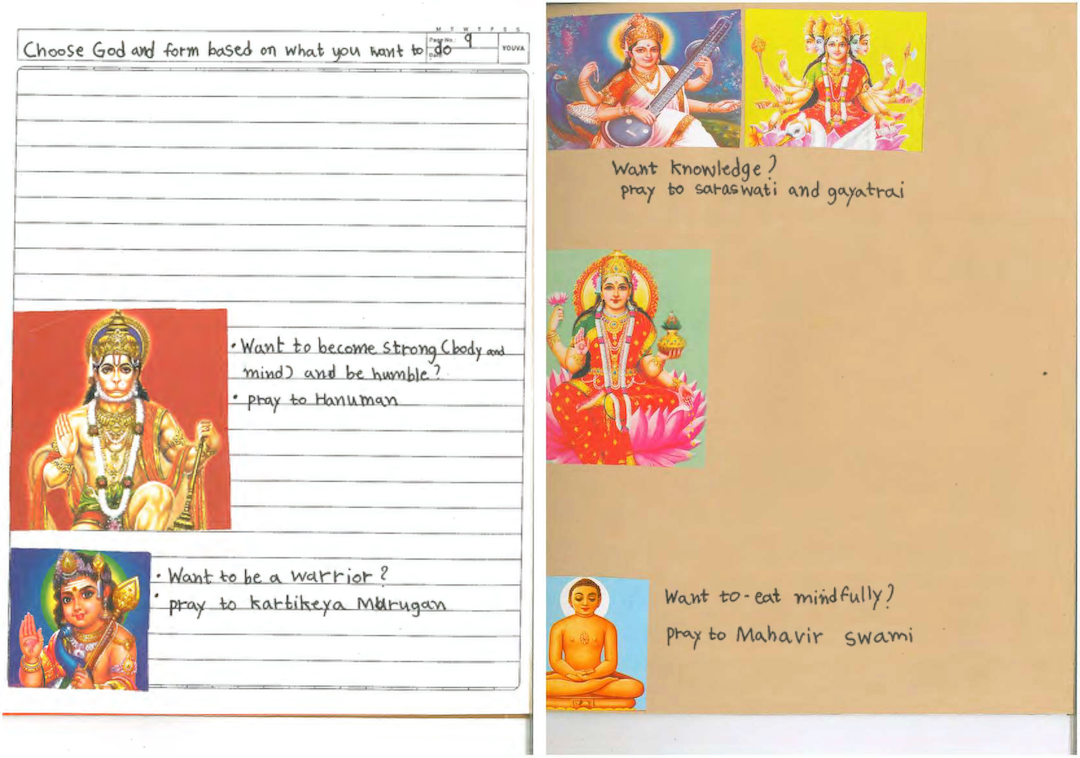
Creating Out of Nothing
Deities ≠ Avatars ≠ Saints
- Avatars are gods in human form. Like Rāma or Krishna.
- Sants are humans made divine. Like Sai Baba, Guru Nanak, Ravidas.
- Deities are technologies—or tools—created to solve a specific need. A deity is a particular combination of Śiva and Śakti, designed to address a problem within a given context. Each deity carries the knowledge—why, how, and what—you need to achieve your goal. Through them, you access the energy and matter required to bring your intention into reality.
Śaivism gave humans the permission to create deities.
You can summon energy and matter out of Śiva to manifest or create sṛṣṭi (creation), even deities.
Examples of deities created by the Gods:
- Durgā — gods combined energies to defeat Mahīṣāsura.
- Ayyappa — born of Śiva and Mohini (Vishṇu’s female form), to destroy Mahishī.
- Bhairava — Śiva’s wrath in form. Destroys arrogance.
- Sarasvatī — created by Brahmā to give voice and memory to creation.
Examples of deities created by Humans:
Santoshi Maa: Created in the 20th century through women’s vrat stories and folk devotion; popularized by the 1975 film as a goddess of contentment and harmony.
Bhārat Māta — emerged during the freedom struggle in 1905. Became a symbol of the nation.
Śītalā Devi — goddess of disease and healing. Grew from rural practice (~16th century).
Vāstu Puruṣa — spirit mapped into sacred architecture (~6th–11th century).
Mātaṅgī — the outcaste form of Sarasvatī. Represents forbidden knowledge (~10th–12th century).Unity in Diversity
Here’s how Indic faiths see each other:
- Shiva, Cit, Shakti = Consider the tea plant. Genetically, there’s only one tea plant — Camellia sinensis.
- Each Religion (upāyas) = Yet its flavor, fragrance, and form vary depending on where and how it’s grown.
Hence, all Dharmic religions — Hinduism, Buddhism, Jainism, and Sikhism — share three foundational beliefs:
- Karma: Actions have consequences
- Reincarnation: Life continues in different forms
- Moksha: Returning back to Shiva is the goal
The variety exists because each ātmā carries its own karma, antaḥkaraṇa, and lived experience. This ever-changing information gives rise to new sṛṣṭi (creations), resulting in endless variety.
The essence is one. The expressions are infinite.
Do you’ve balance between Śiva and Śakti? What is the transformation they want to drive through you?
FAQs
Can women be worshiped?
Some religions see women as material to be owned. This isn’t the case with Indic religions. The worship of Devi (Shakti) is not peripheral but central to Hindu culture. Every village has a Kula Devi. She is not just mother or wife but also protector, creator, and guide.
Can women do great things?
Women can achieve great things—it’s just that what they do may be different from what men do. Without Jijabai (Shivaji’s mother), and warrior women like Tarabai and Rani Laxmi Bai, the Maratha empire would not have existed.

